

|
||
| Northwest Citroën Owners Club | Club Magazine PCN | Contacts |
| History of the PCN Magazine | ||||||||||
| Sample Articles | ||||||||||
|
||||||||||
| Sample PCN 1 | ||||||||||
| Sample PCN 2 | ||||||||||
| Sample PCN 3 | ||||||||||
MYSTERIOUS MICHELIN MUSEUM
by NWCOC Editorial Staff
In 1995, the International Citroën Club Rally (ICCCR) was held on the Michelin test track at their worldwide headquaters in Clermont-Ferrand, France. Ever since ICCCR '95, I had heard rumors of a private Michelin museum somewhere in Clermont-Ferrand. But the museum was only rumored to exist and if it existed at all, was seldom seen by the public.

Clermont-Ferrand
Recently, my job allowed me to
work closely with Michelin of France on a project. The project
required several trips to Michelin's Clermont-Ferrand headquarters. On
the second visit, I felt that I had generated enough of a relationship
with my Michelin counterparts to ask if I could visit the mysterious
museum.
Sure enough, a museum does exist, and I was invited to see it! But my
Michelin counterpart had himself barely known of its existence! I was
driven to an anonymous industrial building near downtown
Clermont-Ferrand. The building had no way to distinguish itself as a
Michelin building. Furthermore, I found it especially curious that the
museum was not located within the gated, sprawling, and highly secured
Michelin complex itself.
There are several floors to the building and each look to be used
primarily for storage. But on the second floor, sure enough, there is
a large area set up in a museum format.
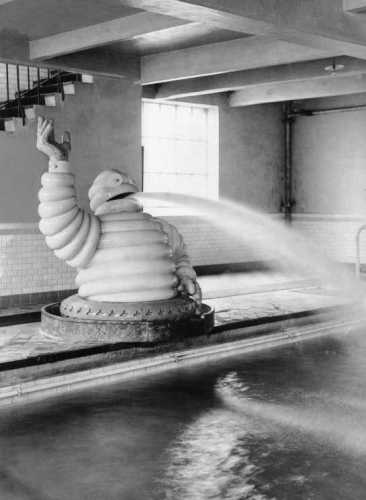
Bibendum fountain
Once inside, we had to search
for the circuit breakers to turn on the lights. We were all alone in
this huge building looking at these strange and wonderful displays. I
got the impression that very few had ever been inside. It was not
clear whether cameras were allowed, but I brought mine in anyway.
So what was inside this mysterious museum? There were bikes, cars,
motorcycles, Bibendum memorabilia, and of course, 110 years of tire
evolution! And yes, there were Citroëns - three on display and
others in the storage areas. Pictures of the inside of the museum
follow, but first, lets take a look at 170 years of Michelin company
history:
| 1829 | Edouard Daubrée marries a Scot named Elizabeth Pugh Barker, niece of the Scottish scientist named Mackintosh who discovered the solubility of rubber in Benzene. Elizabeth introduces rubber into the Auvergne region of France by manufacturing balls out of rubber for her children to play with. |
| 1832 | Two cousins, Aristide Barbier and Edouard Daubrée open a small manufacturing plant for farm machinery and pumps in Clermont-Ferrand, France. |
| 1863 | They set up a partnership called Barbier Daubrée & Co., which is soon changed to E. Daubrée & Co. |
| 1867 | J.G. Bideau, a lawyer is appointed to co-direct the company with Ernest Daubrée (who succeeded his father Edouard Daubrée). |
| 1868 | The company name is changed to J.G. Bideau & Co. |
| 1889 | Edouard
Michelin, who had been operating a painting studio in Paris, takes
over management of the J.G. Bideau company and renames it Michelin
& Co. (or 1891, depending on source) A bicyclist happens to show up on the doorstep of Michelin & Co. looking for materials to repair a damaged Dunlop tire for his bike. |
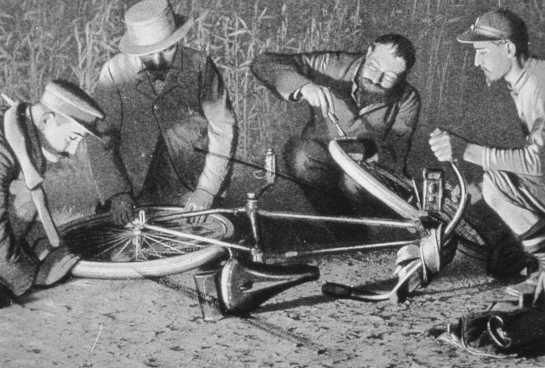 Tire change |
|
| It takes 3
hours of labor and an overnight drying time to repair the tire. The
next morning when the bike was ready, Edouard Michelin tried to ride
the newly repaired bike on the streets of Clermont-Ferrand. But
within minutes, he returned on foot - the repair had failed! Edouard
could not believe this ordeal and set off to develop a bicycle tire
that is easier to repair. This single event is credited for igniting
the Michelin tire empire. Later this year, Michelin files its first patents for detachable tires (this tire can be repaired in 15 minutes!). |
|
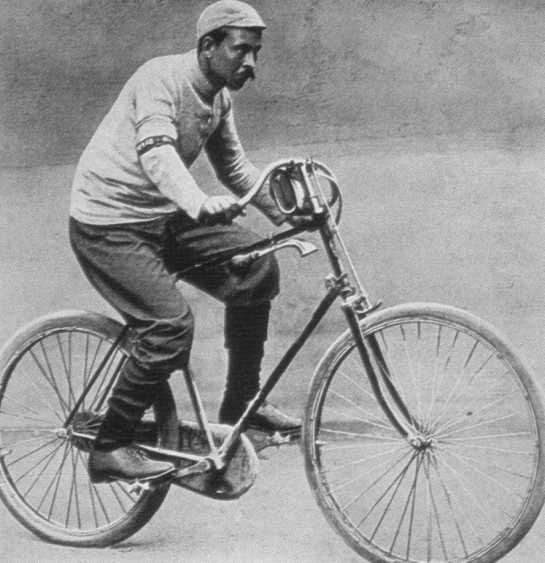 Charles Terront |
|
| A bicyclist named Charles Terront wins a prestigious bicycle race on a bike equipped with detachable Michelin tires, giving Michelin outstanding public visibility. | |
| 1892 | Edouard Michelin foresees that the pneumatic tire will play a central role in the emerging transportation industry and focuses strongly on tire development. |
 Brothers Andre and Edouard Michelin - 1885 |
|
| 1895 | A car, driven by Edouard Michelin and his brother André, completes the Paris-Bordeaux-Paris race (1200 km). This is the first automobile to be equipped with pneumatic tires! |
| 1898 | As Edouard Michelin is approaching the Michelin tire display at an exposition in Lyon, he sees a tall stack of Michelin tires and remarks to his brother André, "Give it some arms and legs and it would look like a man!" Soon after, the Michelin man corporate mascot is born with the help of an artist named O'Galop. |
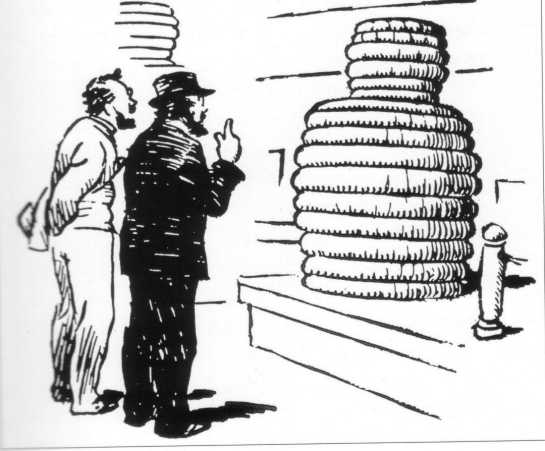 Inspiration for Bibendum |
|
| 1898 | On one of the first advertising posters with the Michelin man, he is shown drinking a goblet of sharp objects signifying that Michelin tires can "drink" sharp objects. Across the top of the poster, there is a latin verse, "Nunc est Bibendum!" This verse translates to "It's time to drink!" Henceforth, the Michelin man was named, Bibendum. |
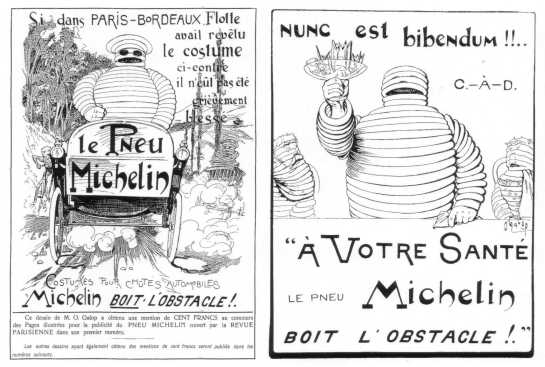 Thought to be the first and second Bibendum advertisements (1899) |
|
| 1900 | Michelin publishes their first travel guide, presumably to make travel easier and hence generate more of a demand for Michelin tires. |
| 1905 | The Michelin plant in Clermont-Ferrand is expanded to cover 74 acres of land and employs 4000 people. |
| 1907 | Michelin opens its first tire manufacturing plant in the USA (Milltown, New Jersey). |
| 1913 | Michelin invents the first detachable steel wheel. |
| 1914 | Michelin starts building airplanes in Clermont-Ferrand as part of the WW1 war effort. |
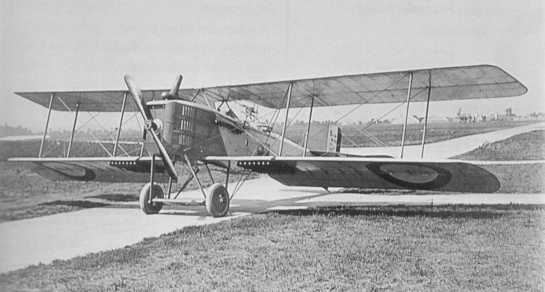 Early bi-plane |
|
| 1916 | Michelin builds the world's first paved airplane runway, located in Clermont-Ferrand. |
| 1928 | Edouard Michelin appoints his son, Etienne, as co-director of the company. |
| 1934 | Michelin takes control of the financially troubled Citroën company. Fortunately, Michelin decides to continue with the Traction Avant project. |
| 1935 | Pierre
Michelin (another son of Edouard) is named president of the Citroën
company and Pierre Boulanger is named vice president. Citroën launches the TPV program (Tout Petit Véhiclule). As we all know, this became the 2CV. |
| 1946 | Michelin files for a patent on the first tire of radial construction on June 4. |
| 1948 | The 2CV is launched at the Paris Auto Show. |
| 1949 | The Michelin radial tire is named with the "X" nomenclature. |
| 1955 | Francois Michelin (son of Etienne Michelin) becomes co-director of the company. |
| 1974 | Michelin sells its shares in the Citroën company. |
| 1981 | Michelin introduces the "AIR X," the first radial tire for aircraft. |
| 1994 | Michelin introduces their "Energy" range of car tires, designed to reduce rolling friction and hence improve fuel consumption. |
| 1998 | Bibendum celebrates his 100th birthday. |
Now for some photos of the museum:

Yup, that is a perfect
2CV Sahara in the background
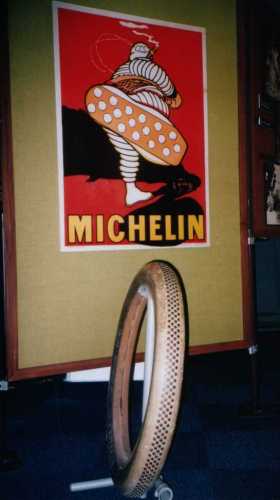
Metal rivets were used
in an early attempt to improve traction

Early attempt at snow
chains, using leather straps and metal rivets
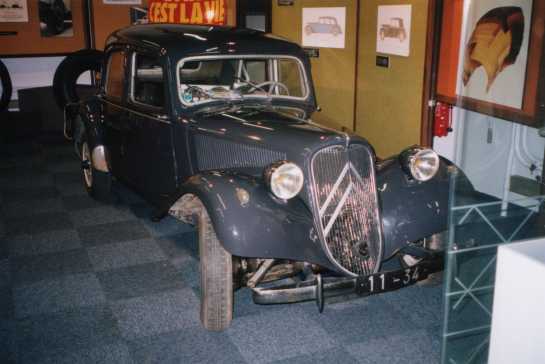
Post-war Traction Avant
used for tire testing

Test equipment inside
the Traction
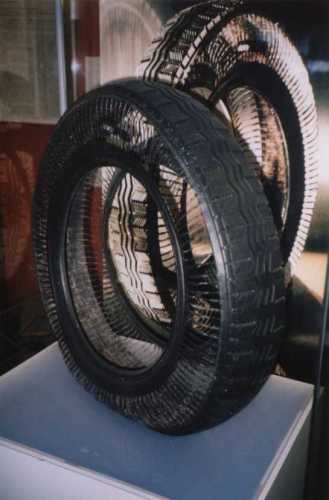
Very Famous Cutaway
Tire showing radial construction (1946). This tire is featured in the
spring 2001 issue of Invention & Technology Magazine
| Back to Top ^^ | ||